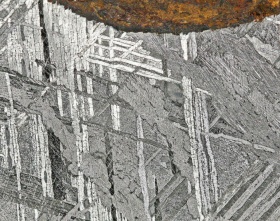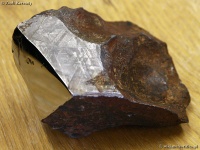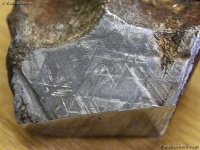(Unless otherwise stated, the copyright of the materials included belong to Jan Woreczko & Wadi.)
Kaposfüred
Z Wiki.Meteoritica.pl
| Kaposfüred → | |

Detale wytrawionego przekroju meteorytu Kaposfüred (źródło: Kubovics et al. 2016)
| |
| Spadek nieudokumentowany (Undocumented) | |
| Lokalizacja | Kaposfüred, Kaposvár, Węgry |
| Położenie[1] | 46°25'N, 17°46'E |
| Data | 7 maja 1995 r., 03:00 (niedziela) |
| Uwagi | meteoryt został zarejestrowany warunkowo (provisional) |
| Charakterystyka | |
| Typ | meteoryt żelazny IVA, oktaedryt drobnoziarnisty (Of) |
| Masa | 2,2 kg |
| Liczba okazów | 1 okaz |
| Meteoritical Bulletin Database | |
Doniesienie o „spadku” meteorytu żelaznego 7 maja 1995 roku (niedziela) na Węgrzech. Meteoryt został zarejestrowany warunkowo (provisional) w Meteoritical Bulletin, jako nieudokumentowany spadek (Undocumented). Okaz rzeczywiście jest meteorytem, ale okoliczności jego „spadku”, są mocno wątpliwe!
Historia „spadku” za Bérczi et al. (1998):
Abstract: An iron meteorite fell in Kaposfüred, Somogy County, Hungary, on May 7, 1995, at 3 a.m. (geographical coordinates are: 17°46'E longitude and 46°25'N latitude). The meteorite arrived from NE direction with high inclination path and excavated a ca. 1 meter deep crater in the garden of a local priest. The mass of the meteorite is 2.2 kg, its density is 8.14 g/cm³. INAA studies showed, that Kaposfüred belongs to the IVA group of irons.
The history of the fall: On the evening of May 6, 1995, Mr. Marcell Török[2], a parish reverend of the Kaposszerdahely Roman Catholic Parochy (priest of the Kaposszerdahely Roman Catholic parish), decided that he would get up early in the morning to scythe the grass in his garden. Next dawn he was awakened by some brightness outside and while opening the door he observed the impact of a bright object at a distance of 7-8 m in his garden. He felt the turbulence caused by the incoming body and observed its shining tail. Since all this happened during the Bosnian war, his first idea was that a projectile had landed. He consulted his watch: it was 3 a. m. He went back to sleep and about 2 hours later he examined the mysterious object and found that it had dug up the soil in East-West direction. (He found that the impacted body had thrown out the soil towards the west, in the direction of the Kaposvár–Fonyód railway line). The diameter of the crater was about 1.5 meter and its depth was 1.1 meter. The crater was elongated towards Western direction and this fact signified the East-North-East arrival path. He also observed, that the projectile had decapitated one of his pine trees and melted the aluminium washing line. Then the priest tried to take out the object from the crater which melted his spade. Finally he managed to excavate it and put it in a bucket of water which was evaporated immediately.
Okaz wygląda na za bardzo zwietrzały, jak na świeży spadek! Cała ta historia pełna jest niedorzecznych, wręcz absurdalnych faktów! Świadkiem „spadku” był ksiądz Marcell Török![2] No comment.
W lutym 2016 roku sprawa meteorytu Kaposfüred została wyjaśniona przez Zsolta Kereszty i współpracowników (Kubovics et al. 2016).
W skrócie: świadek spadku(?) meteorytu Nagy-Vázsony[3] dokonał podmiany okazu na okaz meteorytu Toluca[4] i ten został wysłany do zbiorów muzeum w Wiedniu, gdzie znajduje się do dziś (Nagy-Vázsony z Wiednia został sklasyfikowany, jako meteoryt żelazny IAB-sLL, tak jak Toluca). Oryginalny okaz meteorytu Nagy-Vázsony był w Szeged, a później przechowywany w Kaposfüred.
Czyli w zbiorach MHN w Wiedniu znajduje się nie okaz meteorytu Nagy-Vázsony, tylko meteorytu Toluca typu IAB-sLL. Oryginalny meteoryt Nagy-Vázsony (=Kaposfüred) jest typu IVA.
Lokalizacja
(K) Kaposfüred, (N) Nagy-Vázsony
miejsce znalezienia (spadku!) (46°24′47,47″N, 17°46′45,29″E)
[IVA] miejsce spadku meteorytu Nagy-Vázsony
* W 2018 roku Google zmieniło zasady działania apletu, mapa może wyświetlać się niepoprawnie (pomaga Ctrl+F5); więcej → Szablon:GEMap-MyWiki
Meteoryt spadł na teren plebani, w miejscu o współrzędnych 46°24′47,47″N, 17°46′45,29″E.
Galerie
Masa główna (fot. Zsolt Kereszty, za zgodą)
Bibliografia
- +Bérczi Szaniszló, Földi Tivadar, Kubovics Imre, Simonits A., Szabó A., (1998), Kaposfüred: A new IVA-type iron meteorite from Hungary, 29th Lunar and Planetary Science Conference, March 16–20, 1998, Houston, Texas. Plik PDF.
- Koblitz Jörn, MetBase. Meteorite Data Retrieval Software, Version 7.3 (CD-ROM), Ritterhude, Germany 1994-2012. MetBase.
- +Kubovics Imre, Bérczi Szaniszló, Ditrói-Puskás Zuárd, Gál-Solymos Kamilla, Nagy B., Szabó A., (1997), Preliminary report of Kaposfüred: A new iron meteorite from Hungary, Acta Mineralogica-Petrographica, 36(1), Szeged 1997, s. 111–117.
- +Kubovics Imre, Kereszty Zsolt, Bérczi Szaniszló, Gönczi Gy.A., (2016), The revealed real story of the Nagy-Vázsony[3] irom meteorite, 47th Lunar and Planetary Science Conference, March 21-25, 2016, Woodlands, Texas. Plik PDF.
Przypisy
Linki zewnętrzne
- Meteoritical Bulletin Database (MBD) – meteoryt (provisional) Kaposfüred
- Encyclopedia of Meteorites (EoM) – meteoryt (provisional) Kaposfüred
- Muzeum Historii Naturalnej w Budapeszcie (Hungarian Natural History Museum, Budapest; Budapest, Nat. Mus.) – Magyar Természettudományi Múzeum Budapest ●
Katalog Tokody (1951) ● Meteorites in the Carpatian Basin (english); Kárpát-medencei meteoritok (hungarian)● [katalog → Ravasz (1969)]
- woreczko.pl – o składzie heksaedrytów i oktaedrytów: Figury, struktury Widmanstättena (Widmanstätten pattern; Widmanstatten)
- Wikipedia (HU) – Kaposfüred vasmeteorit

